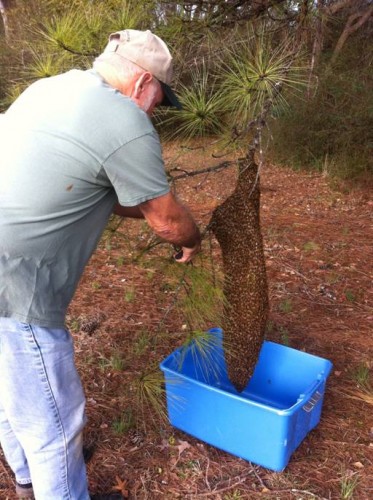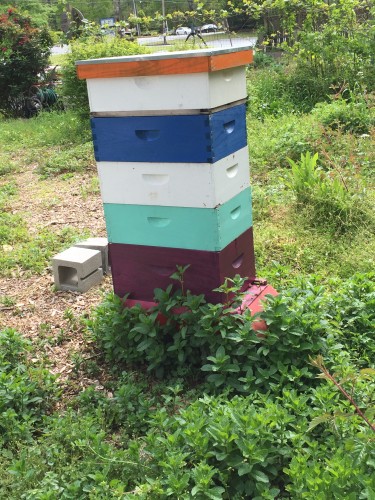





Q: My neighbor is a beginner beekeeper. His bees like to get water from my pool but I am allergic to them. What can I do?
A: Tom Bonnell, Henry County beekeeper, says honeybees are one of the most beneficial insects to humans. They help pollinate our crops (like apples, melons and almonds), produce sweet honey, and make beeswax.
His quick tips follow, but scroll down beyond them to get the full story.
First:
Talk to your neighborhood beekeeper, explain the problem and ask if they have a water source near their hives. All good beekeeping programs tell beginning beekeepers, “You must have a water source for your bees and it’s not your neighbors swimming pool.”
Second:
Time to take matters into your own hands.
1. When you first notice bees around your pool, mix a 1/4 cup of dish soap to a quart of water, and fill an empty sprayer bottle with it. Using the soapy mixture, spray any bees that are at your pool.
2. This soapy mixture will kill the bees quickly and without harmful pesticides in the pool..
3. Do this every time you see bees at a water source you want to keep bee-free.
4. This will kill those foragers who are telling others in the colony where your swimming pool is located. Eventually, all those foragers who are not returning to the colony will have died. Other foragers will find a different source of water, so do not worry that you are harming the colony. Your are only eliminating a few individuals.
Full comments:
Because bees are a social insect, living in colonies of up to 60,000 bees, they need lots of food and water to keep the hive alive. The queen lays eggs in the colony and the worker bees do all the work. Worker bees normally forage on flowers for nectar and pollen. Nectar is the sweet flower sap that bees make into honey. Pollen is the protein resource bees feed their young larvae.
Bees store their food and raise their young in honeycomb cells. Honeycomb cells are made from beeswax, which is secreted by young worker bees, and fashioned into the familiar honeycomb hexagonal shape. Bees have to keep the hive at a constant temperature, not only to keep the colony from overheating, but also to prevent the wax from melting. In hot weather, bees cool the colony much like an evaporative cooler does – by evaporating small drops of water. Worker bees collect water and spread it throughout the colony in droplets. Then worker bees fan the air with their wings to create an air stream over the water drops, causing the water to evaporate and thus lowering the hive temperature.
When bees forage for water, they are not fussy about where they get it. It could be from a mud puddle, a stream, swimming pool, pond, dog bowl or birdbath. It is when bees come in contact with people, especially at swimming pools, that people notice them. Then they are considered not only a nuisance, but also a hazard.
I have to tell a story I was told by an elderly lady at one of my bee programs. In my program I talked about the need of a water source. After the program ended the elderly lady came up to me and said, “I understand about the water source, when I was growing up my Dad was a beekeeper, as was his Dad, and the only water source we had was the outhouse and I remember fighting honeybees every time I needed to use it.” Then she added with a smile, “And let me tell you this, I never ate any of that honey!”

beekeeper recovering a bee swarm

Copyright © www.100flowers.win Botanic Garden All Rights Reserved